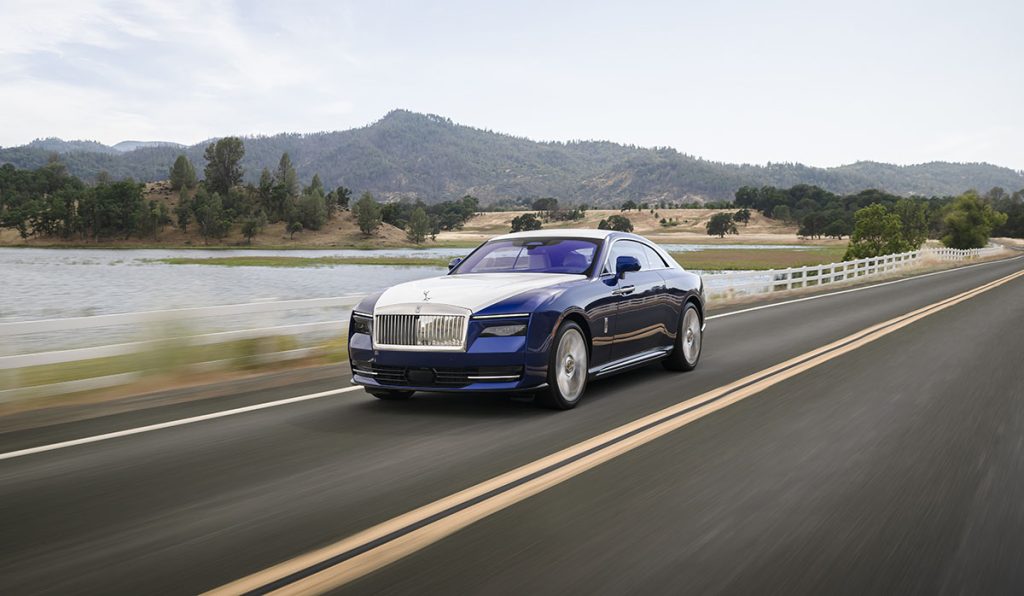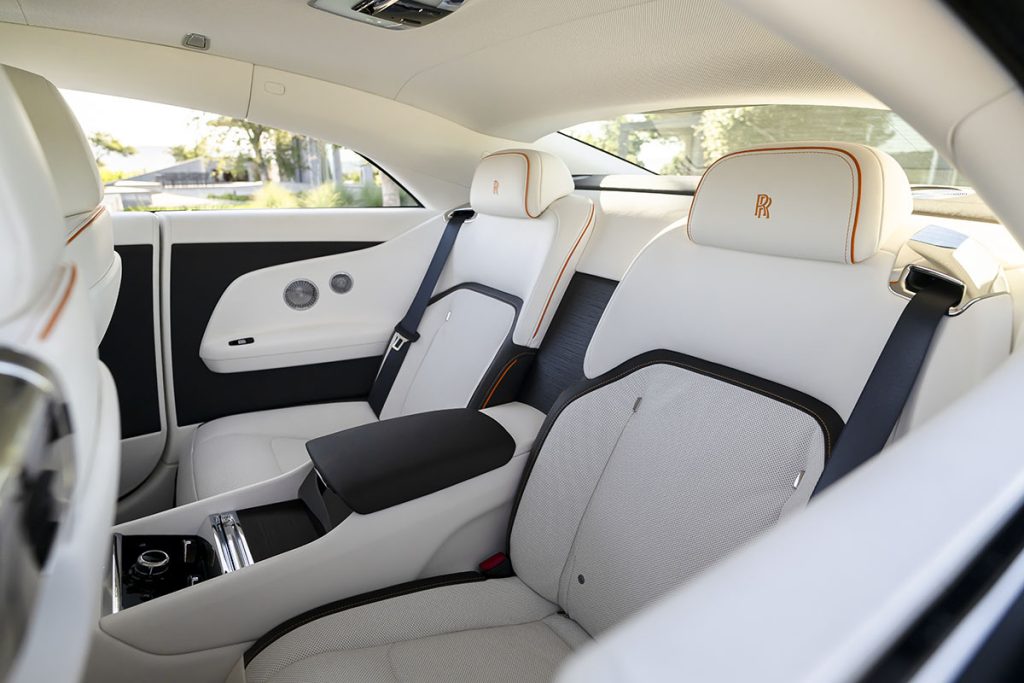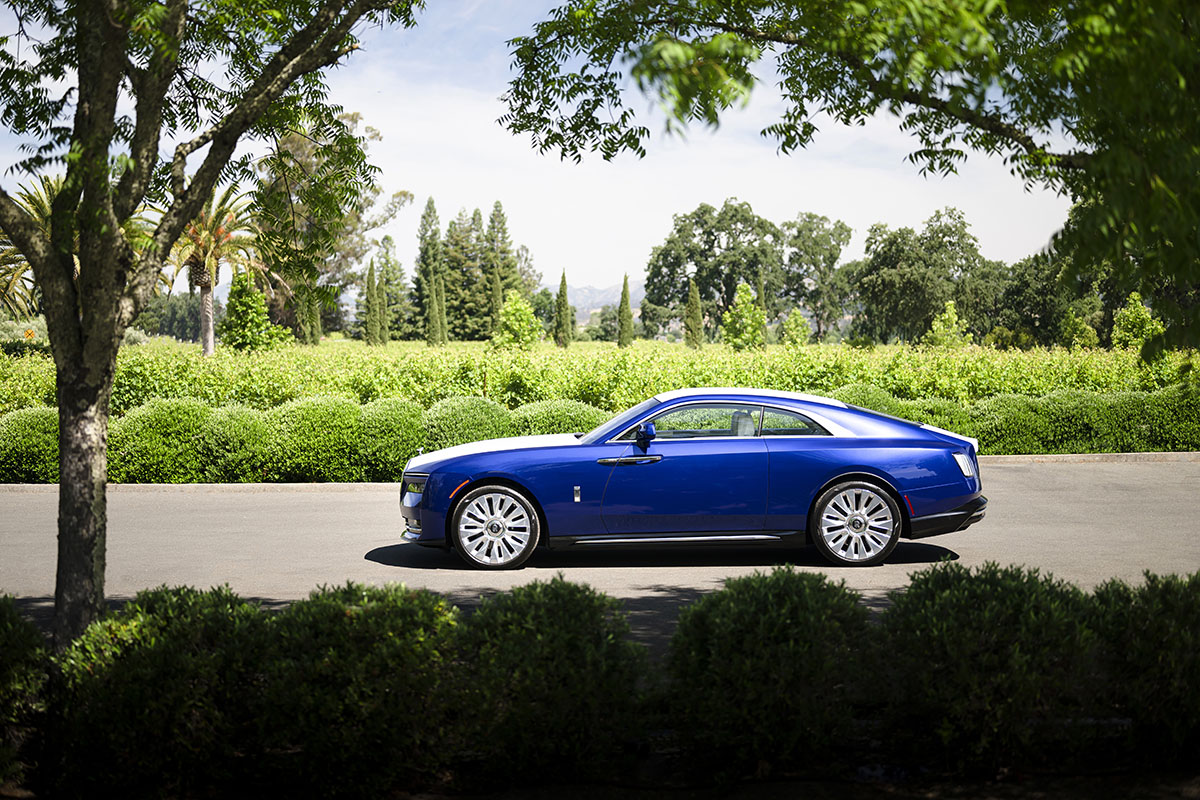It’s a bright and clear morning in California. Layers of fog, characteristic of the early hours, have dipped, risen, and disappeared to reveal uninterrupted skies and a row of cars lined up outside Four Seasons Napa Valley like jewels on a rivière necklace. Polished, pristine, and capturing different ‘personalities’ of one model, they glisten in shades of Salamanca Blue and Artic White; Midnight Sapphire and Silver; Morganite; Tempest Grey; Imperial Jade and Black Diamond; Gunmetal; Chartreuse; and Olivin and White Sands, as their metallic-flecked bodies catch the light.
This is Spectre, one of the most anticipated cars in history and one that Rolls-Royce believes will usher in a new electric dawn. Committed to an uncompromisingly electric future ― the marque will only make fully electric vehicles by the end of 2030 ― Spectre is an all-electric drivetrain rather than a hybrid solution and one that recalls a prophetic statement made by Rolls-Royce co-founder The Honourable Charles Stewart Rolls in 1900, four years ahead of his first meeting with Henry Royce. The motoring pioneer declared in a magazine article: “The electric car is perfectly noiseless and clean. There is no smell or vibration. They should become very useful when fixed charging stations can be arranged.” Over a century later and those words have come to fruition.

Where better to put the ambitious release to the test than in California ― a state that embodies many of the electric world’s most important components. Synonymous with innovation and clean energy technology, California is a pioneer in climate and environmental sustainability; setting the nation’s first economy-wide greenhouse gas limit, the first climate emissions standards for cars, and committing to 100 per cent renewable energy by 2045.
It’s also a hotspot for seasoned Rolls-Royce clients. Here at Four Seasons Napa Valley ― an early adopter of fully electric hotel cars provided to guests ― surrounded by lush vegetation, temptingly undulating roads to explore, and a fleet of Spectre cars, will the world’s first ultra-luxury electric super coupé live up to its billing?

“In 2020 I made a promise to deliver an electric Rolls-Royce within this decade”, says CEO Torsten Müller–Ötvös. “But the beginning of my quest to electrify our marque goes back to 2011 and the unveiling of the 102 EX Phantom Experimental Electric. A couple of years later we showed the visionary 103 EX. Both were extremely important cars in their different ways, as we explored what possibilities electric drive could offer. We’ve continued to explore and experiment ever since. Spectre is the result of more than a decade’s dedicated effort ― a relentless, restless pursuit of perfection. Because one thing has been clear in my mind from the very beginning: this car, which we now know as Spectre, must be a Rolls-Royce first and an electric car second. No compromises.”
Design
Drawing inspiration from the worlds of haute couture, modernist sculpture, and nautical aesthetics, Spectre goes beyond the sphere of automotive and, characteristically for Rolls-Royce, into the realms of art. Naysayers concerned that all-electric would undermine the brand’s visual appeal need not have worried. Spectre’s design is exactly what one would expect from the marque. In short, it looks like a Rolls-Royce.

House codes are met with elegant updates. The elongated Pantheon grille ― the widest ever fitted to a Rolls-Royce ― can be softly illuminated with LEDs to create a subtle three-dimensional signature at night. Proportions elsewhere are similarly generous, with Spectre becoming the first Rolls-Royce two-door coupé to be equipped with 23-inch wheels in almost 100 years and, at almost 1.5 metres in length, Spectre’s laser-welded pillarless coach doors, equipped with a specially developed iteration of the Effortless Doors power-assisted system, are the largest ever fitted to a Rolls-Royce.
Every detail of the exterior has been carefully considered to bolster the model’s aerodynamic profile, from the seamless roofline to a beautifully reimagined Spirit of Ecstasy figurine created specifically for Spectre. Featuring a lower stance that took over 830 hours of design modelling and wind-tunnel testing to perfect, it contributes to the motor car’s impressive drag coefficient and sees Spectre become the most aerodynamic Rolls-Royce ever built.

Engineering and design feats result in a vehicle that boasts range and battery life in-keeping with the demands of Rolls-Royce clients and one that refuses to compromise on interior space, comfort, performance or ride quality. Spectre is also the most connected Rolls-Royce in history, with three times as many sender-receiver signals as any previous model; and, because there is no margin for error at the meticulous marque, each of the car’s thousands of drivetrain and chassis characteristics were exhaustively tested and refined during its 2.5-million-kilometre testing programme.
The drive
The experience of driving Spectre is almost impossibly smooth ― good news for clients who have ordered the car without a test drive; itself a reflection of their trust in the marque. “Spectre takes what Rolls-Royce and our legendary V12 are famous for ― silence, refinement, almost instant torque ― and brings them into ultra-high definition,” says Müller–Ötvös. “It proves that we can deliver our authentic Rolls-Royce ‘wafting’ driving dynamics and signature Magic Carpet Ride without an internal combustion engine.”

That Magic Carpet Ride sensation, a key piece of terminology in the Rolls-Royce lexicon, refers to a feeling of flight on land, a quality akin to floating above the surface of the road; an elevated state that conjures the smoothest of rides. This isn’t, in other words, like driving just any electric car. “This is exactly the challenge we had,” adds Dr. Mihiar Ayoubi, Director of Engineering. “We needed to elevate the experience to the level of Rolls-Royce. I’d like you to visualise Spectre suspended by an imaginary hook in the sky, gliding forwards, unaffected by the road conditions. This is our so-called Magic Carpet Ride – and what we refer to as skyhooking the body of the car.”
Whilst a coupé isn’t usually a chauffeured vehicle, the comfort and space afforded to passengers means that it could easily fulfil that function. “We refer to the back seating as a ‘cossetting art lounge’”, says Anders Warming, Director of Design, “because you sit in the car encompassed by beautiful, curated surfaces.” Its cocooning interior provides an ideal canvas for bespoke personalisation, complemented by a unique illuminated fascia and the first Starlight Doors ever specified in a production Rolls-Royce.
It’s that level of innovative detail that really sets Spectre apart. Heritage can be a double-edged sword ― so focused on the past that the future becomes secondary. Not so with Spectre, in which archival nods meet contemporary sensibilities and forward-thinking engineering. “When we design a Rolls-Royce we celebrate the stories of our heritage, our artisans, and our patrons”, says Warming. “The [Hon Charles Stewart Rolls’] prophecy is not only important to the story of the electric drivetrain, but also to the fact that we are using design elements in our cars that reference cars of the past, for example the coach doors and design of the front of the car. This is where we pay tribute to the founders, and their spirit continues in this car.”
Spectre is, then, the future ― taking the brand’s design lexicon and bespoke capabilities into a new, electric age. “Spectre is the Rolls-Royce that changes everything”, says Müller–Ötvös. “It is a truly transformative product that completely redefines the category of super-luxury motoring. Once again, we have followed the command of Sir Henry Royce himself to ‘take the best that exists, and make it better’.”
